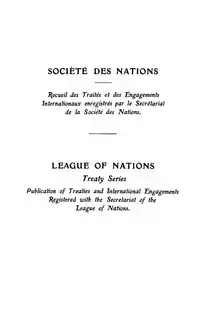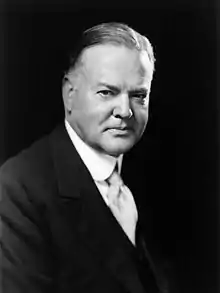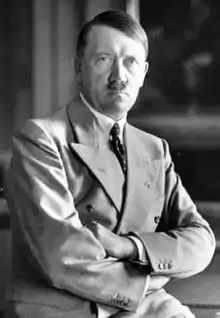Geneva Conference (1932)
The Geneva Conference was a response to militarisation of global powers after World War I and was aimed towards global disarmament. The Geneva Conference of 1932 was organised and campaigned for by the League of Nations with the main objectives of avoiding another war. Whilst the Conference is generally perceived as a failure, mainly because of the onset of World War II five years later and the withdrawal of Germany, at the time the conference symbolised global cooperation to a combined goal of limiting arms.
| Geneva Conference 1932 | |
|---|---|
| Begins | 1 February 1932 |
| Ends | November 1934 |
| Location(s) | Geneva |
| Coordinates | 46.2044° N, 6.1432° E |
| Country | Switzerland |
| Participants | 31 Nations including the USSR, The United States, Germany and Great Britain |
| Organised by | The League of Nations |
The conference involved 31 nation states including the USSR, The United States, Germany (at the beginning although they later withdrew under Adolf Hitler’s leadership) and Great Britain. The main achievements of the conference included defining aggressively offensive weapons, reasonably defensive weapons, abolishing submarines, aviation, and heavy-duty tanks and limiting land forces.
This conference is seen as the first of its kind in a long history, continuing to today for global disarmament and peace.
Background
Arms development
During World War I, the world and Europe in particular underwent a vast arms development. During the course of the war, technology surrounding weaponry development and new types of arms emerged. Specifically, a focus not only on land equipment and personal but on naval and air force[1] which Borg, describes as having “considerable weight and influence”.[2]
These developments included but were not limited to, aircraft (used for infantry support, photographing infantry positioning and bombing), naval warfare (including submarines and German U-Boats) and land armaments (including gases, machine guns and grenades).[3]
The aim of the Geneva Conference 1932 was disarmament targeting military (land), air and naval programs (Covent of the League of Nations Article 8).[4]
Death toll of World War I
World War I started in 1914 and lasted until the end of 1918.[3] The 'Great War' (as it was called at the time) was the largest geo-political conflict of its time and involved mostly all of Europe as well as parts of Asia, Australia and The United States.[3] Whilst exact numbers are unknown, historical researches places the number of people (both civilian and military) who died in World War I at 37.5 million.[5]
| Country | Total deaths/missing military personnel |
|---|---|
| Soviet Union | 1 900 000 |
| Germany | 1 800 000 |
| France | 1 200 000 |
| Austria Hungary | 900 000 |
| Great Britain | 900 000 |
| Italy | 450 000 |
| America | 50 000 |
| Total | 'c. 37.5 million |
Antiwar sentiment
Following World War I, the extensive death toll and social effects of ‘total war’ resulted in a general antiwar sentiment and encouraged the general sentiment of disarmament. The British Women's Society received 8 million signatures in support of disarmament and are accredited with a driving force behind the convening of the Conference.[6]

The Treaty of Versailles
The Treaty of Versailles was signed on June the 28th 1919 and laid out the terms for the Germans' conditional surrender in World War I, including their national disarmament.
Notable clauses
- Article 160: German army to have no more than 7 divisions of infantry, 3 of cavalry, no more than 100 000 men, officers must not exceed 4000
- Article 165: limits of guns, machine guns, ammunition, and rifles
- Article 168: limited manufacture of munitions (to be overseen by the League of Nations)
- Article 170: limited any importation of arms[7]
The Geneva Conference 1932 intended on enacting the terms of the Treaty of Versailles, specifically in regards to German disarmament.
Involved Nations
The Geneva Conference 1932 involved all nations signatory to the Covenant of the League of Nations. This included the United States, Great Britain, France, Italy, and Japan as permanent member of the League of Nations Council.[4] All Allies who signed the Peace Treaty of Versailles, including Germany.[8] And all ‘war neutral’ parties such as Switzerland who had vested interest in disarmament in Europe specifically.[8]
The League of Nations
According to Gumbrecht the League of Nations was created with “the ideal of establishing a family of nations united by shared goals of peace[9]”. The Covenant of the League of nations was published on the 28th of April 1919 by unanimous agreement.

Article 8 of the Covenant of the League of Nations states “the members of the League recognise that the maintenance of peace requires the reduction of national armaments to the lowest point consistent with national safety and the enforcement by common action of international obligations”.[8] The Geneva Conference 1932 was convened by the League of Nations with the intention of fulfilling the terms of article 8 and progressing towards global peace via the process of disarmament.
Negotiations
The conference convened on the 1st of February 1932 in Geneva, Switzerland. The intention of the Conference was implementing strategies to fulfill Article 8 of the Covent of the League of Nations.[8]
The US ambassador to Belgium and minister to Switzerland and conference delegate, Hugh S. Gibson, had observed not long after the London Conference, the United States had decreased interest in the new conference because treaties already limited its navy, its army was so small that reduction was ludicrous, and the proposed measures of air limitation were so vague that they meant little. Gibson wrote that the conference would "probably meet in February or March 1932 and, discouraging as it may sound, it will probably go on and on." He had come to believe that armaments would never be abolished completely but that treaties could perhaps maintain military balances.
Periods of negotiations
The negotiations can be split into five distinctive categories or periods. As classified by military historian Arther Steiner "first period - emphasis on security, second period - appointment of commissions, third period - the general commissions, fourth period - the technical commission and the fifth period - the Hoover Proposals".[10]
Emphasis on security
This specifically focused on geopolitical relations at the time. This included Russia, Turkey and Persia as well as France and Germany. The main focus was France and developing relations that made the country secure to disarm. This involved a development of American-French and Anglo-French relationships.[10]
Appointment of Commissions
This began of 25 February 1933 and involved finding a representative from each of the states. These representatives formed the General Commission which delegated into the Naval and Air Commissions. This stage was concluded by 18 March 1933.[10]
The General Commission
The third period, dubbed the 'General Commission' was where the bulk of the negotiations took place. This section of the Conference began to attempt to enact the goals of the League of Nations.[10] This primarily involved classifying classes of weaponry and fortifications.
Classifying weaponry
The Covent of the League of Nations defined ‘National Armaments’ as referring to generalised military forces including personnel, equipment, technology etc.[8] The Conference intended to differentiate between offensive and defensive weapons. The negotiations centred largely on the offensive weapons, as a means to stop future attacks rather that reduce the defensive capabilities of nations.[11] However, nations often disagreed about the technicalities of certain weaponry.
Sir Basil Liddell Hart (B. H. Liddell Hart), a British Military Historian who was known largely for his strategy surrounding mechanical warfare[12] was present at the conference. He contended that tanks (a new development of World War I) were both offensive and defensive weapons and could thus, not be classified as either.[11] However, Winston Churchill disagreed, arguing that the offensive capabilities of tanks were tremendous and outweighed any defensive capabilities.[11] This kind of turmoil and inability to agree, halted the progression of the conference.[11]
Fortifications
A key negotiation of the conference involved the discussions surrounding armed fortifications. It was agreed, unanimously, that any fortifications remaining from World War I (developed during the war, not before) along borders had to be abolished.[11] Additionally, coastal fortifications (except between the Baltic Sea and North Sea) could remain but not be worked on, extended or built up.[11]
Additional discussions during the General Commission
In addition, other discussions were brought up during the General Commission. These included whether these agreements were still in place during wartime, whether other regulatory bodies should be established to monitor and enforce this and the option of demilitarised zones. These issue's were agreed upon with the ideal that the agreements set about should be war and peace time, that a non-political body would monitor disarmament and that there would be no specific demilitarised zones.[10]
The Technical Commission
This period was known for its high levels of debate, disagreement and technical issues.[2] Essentially, during this section, nothing was agreed upon nor progressed upon.[10]
The Hoover Proposals
This was the point in the Conference where the US sent a delegate to Geneva and became heavily involved in the Conference.[10]

US President Herbert Hoover, acknowledged the failure and lack of progression of the Conference thus far and proposed for the US to take the lead on disarmament.[13] As argued by Marlies ter Borg the proposal that Hoover presented to the conference on the 22nd of June 1932 was a “potential turning point”.[11] The proposal suggested that the US would abolish all aircraft, submarines, military aviation, tanks, poison gas and reduce one-third of battle ships.[13]
At the time the involvement of the United States "injected life into a nearly dead conference[10]". However, these proposals were never passed through US Congress and whilst showed promise and the spirit of disarmament, did not resonate in the Conference.[11]
Problems with the negotiations
The period of the conference named the General Commission made progress with nations agreeing on a number of terms.[10] However, when it came to individual nation states implementing the terms of the Conference, it was unsuccessful.[14]
There was a failure to obtain a German-French agreement on German arms status as the French did not want to disarm without a guaranteed alliance if war broke out with Germany again.[14] Czechoslovakia and Poland were vulnerable because of their geographical proximity to Germany and fear that they would be attacked by the allies again with no way to defend themselves if they disarmed.[15]
During 1932-1933 the USSR, under the leadership of Stalin underwent a widespread famine known as the Soviet Famine. The USSR was occupied with national issues and was rarely present at the conference.[16] In addition, during the interwar period, Stalin led the modernisation and buildup of the USSR's army. This included the size of an army (during peace time) of 1,100,000 and forced combat training.[16] In December 1931 Molotov talked about "[the] growing danger of military intervention against the USSR".[16] This meant that like many other countries, the USSR were hesitant to disarm.
Additionally, Japan invaded Manchuria on the 18th of September 1931 after the Mukden Incident and were subsequently hesitant and hostile to the idea of disarming. Ultimately, Japan disagreed with the whole idea of disarmament and were not present or involved with negotiations.[14]
Departure of Germany

Adolf Hitler German: [ˈadɔlf ˈhɪtlɐ] (![]() listen) came to power in March 1933 and quickly gained complete authority over the German government. He withdrew Germany from the League of Nations and subsequently the Geneva Conference in October 1933. Whilst Hitler temporarily rejoined the Geneva Conference under the Five-Power Agreement, he quickly re-withdrew Germany as progressions with the Conference began to halt.[10]
listen) came to power in March 1933 and quickly gained complete authority over the German government. He withdrew Germany from the League of Nations and subsequently the Geneva Conference in October 1933. Whilst Hitler temporarily rejoined the Geneva Conference under the Five-Power Agreement, he quickly re-withdrew Germany as progressions with the Conference began to halt.[10]
Military superiority of Germany was a defining element of Hitler's ideology and foreign policy, the idea of disarmament was unacceptable.[17] As soon as Hitler rose to power, he began the process of rearming Germany, clearly defying the Treaty of Versailles and furthermore, the objective of the Disarmament Conference.[17] Hitler drew on the unwillingness of other countries to disarm as justification that Germany shouldn't either.[18]
Outcomes
Ultimately, when Hitler withdrew Germany from the League of Nations and the Treaty of Versailles the French were unwilling to disarm.[15] The conference was ultimately adjourned in November 1934. The British Foreign Office stated that “the failure of the Disarmament Conference would have incalculable consequences for Europe and the League [of Nations]”.[19]
US Secretary of State Henry L. Stimson later wrote that Americans regarded the Geneva Conference as "a European peace conference with European political questions to be settled. The necessary work of settling them must be done by the leaders of Europe." Stimsom realized that Germany's position in European affairs could not be ignored as it had been at Geneva in 1927 or at London in 1930, but he did not know how to reconcile German military ambition with French fear of its neighbor. Stimson therefore hoped the Europeans might find a solution. The secretary also hesitated over further naval disarmament because of the Manchurian crisis; in particular he worried whether the navy possessed enough aircraft carriers for possible action in the Far East.[20]
It is not clear, or unanimously agreed upon as to why exactly the conference failed. However, the majority of academic source and historians blame a combination of the rise of Hitler and withdrawal of Germany from the conference, general unwillingness of nations to disarm, highly unstable political and economic climate and the looming threat of another World War.
References
- Stevenson, David (1 January 2016), Arms Races in International Politics, Oxford University Press, pp. 41–60, doi:10.1093/acprof:oso/9780198735267.003.0003, ISBN 978-0-19-873526-7 Missing or empty
|title=(help);|chapter=ignored (help) - Borg, M. T (9 March 1992). "Reducing Offensive Capabilities - the Attempt of 1932". Journal of Peace Research. 29 (2): 145–160. doi:10.1177/0022343392029002003. JSTOR 424049.
- "World War I | Facts, Causes, & History". Encyclopedia Britannica. Retrieved 27 May 2020.
- The League of Nations and Miscellaneous Addresses, Columbia University Press, pp. 21–110, 31 December 1923, doi:10.7312/guth93716-002, ISBN 978-0-231-89509-5 Missing or empty
|title=(help);|chapter=ignored (help) - "World War I - Killed, wounded, and missing". Encyclopedia Britannica. Retrieved 21 May 2020.
- Webster, Andrew (19 August 2006). "From Versailles to Geneva: The many forms of interwar disarmament". Journal of Strategic Studies. 29 (2): 225–246. doi:10.1080/01402390600585050. ISSN 0140-2390. S2CID 154909587.
- "The Treaty of Versailles". 28 June 1919.
- "League of Nations - The Covenant". Encyclopedia Britannica. Retrieved 21 May 2020.
- Gumbrecht, Hans U., author. (5 February 1998). In 1926 - Living on the Edge of Time. Harvard University Press. ISBN 0-674-00055-2. OCLC 1066536066.CS1 maint: multiple names: authors list (link)
- Steiner, Arthur (6 May 1933). "The Geneva Disarmament Conference of 1932". The Annals of the American Academy of Political and Social Science. 168: 212–219. doi:10.1177/000271623316800128. JSTOR 1019055. S2CID 145367431.
- Borg, M. T (1992). "Reducing Offensive Capabilities - the Attempt of 1932". Journal of Peace Research. 29 (2): 145–160. doi:10.1177/0022343392029002003. JSTOR 424049.
- "Sir Basil Liddell Hart | British military historian". Encyclopedia Britannica. Retrieved 21 May 2020.
- "Foreign Relations of the United States Diplomatic Papers, 1932, General, Volume I - Office of the Historian". history.state.gov. Retrieved 21 May 2020.
- Stevenson, David (1 January 2016), Arms Races in International Politics, Oxford University Press, pp. 41–60, doi:10.1093/acprof:oso/9780198735267.003.0003, ISBN 978-0-19-873526-7 Missing or empty
|title=(help);|chapter=ignored (help) - James, Alan (1986). "The League of Nations: its life and times, 1920–1946". International Affairs. 63 (1): 101–102. doi:10.2307/2620241. ISSN 1468-2346. JSTOR 2620241.
- Shabad, Steven (2003). The Stalin-Kaganovich Correspondence, 1931–36. Yale University Press. ISBN 978-0-300-09367-4. JSTOR j.ctt1bhknv0.
- Müller, Rolf-Dieter; Ancker, Janice W. (15 August 2016), "The Military in the Totalitarian Führer State", Hitler's Wehrmacht, 1935-1945, University Press of Kentucky, pp. 7–42, doi:10.5810/kentucky/9780813167381.003.0001, ISBN 978-0-8131-6738-1
- Edelstein, David M. (15 September 2017), Over the Horizon, Cornell University Press, doi:10.7591/cornell/9781501707568.003.0005, ISBN 978-1-5017-0756-8 Missing or empty
|title=(help);|chapter=ignored (help) - Bennett, Edward W. (31 December 2015). German Rearmament and the West, 1932-1933. Princeton: Princeton University Press. doi:10.1515/9781400871995. ISBN 978-1-4008-7199-5.
- Fanning, Richard W. (1995). Peace and disarmament: naval rivalry & arms control, 1922-1933. University Press of Kentucky. p. 150. ISBN 0813130557.